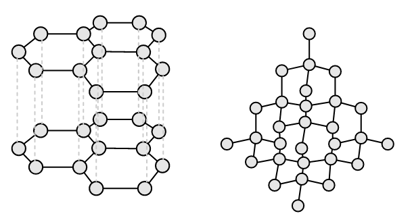Which of the following statements is not correct?
A common functional group is present in different members of a homologous series.
Two consecutive members of a homologous series differ by a group.
The members of a homologous series can be represented by one general formula.
Different members of a homologous series have similar chemical properties.

Important Questions on Carbon And Its Compounds
Compound has the molecular formula .
1. can be made by fermentation process.
2. can be oxidised to .
3. can react with to form and water.
To which homologous series do and belong?
Structures of two different forms of carbon are given below.

Identify the two forms and how are they related to each other?
 is
isIn this section, each question has two matching lists. Choices for the correct combination of elements from List-I and List-II are given as options (a), (b), (c) and (d) out of which one is correct.
| List-I | List-II |
| (P) | 1. Ester |
| (Q) | 2. Carboxylic acid |
| (R) | 3. Ketone |
| (S) | 4. Alkyne |
In this section, each question has two matching lists. Choices for the correct combination of elements from List-I and List-II are given as options (a), (b), (c) and (d) out of which one is correct.
| List-I | List-II |
| (P) Alkyne | 1. |
| (Q) Alcohol | 2. |
| (R) Alkylhalide | 3. |
| (S) Alkene | 4. |
In this section, each question has two matching lists. Choices for the correct combination of elements from List-I and List-II are given as options (a), (b), (c) and (d) out of which one is correct.
| List-I | List-II |
|
(P) Molecules having different physical properties but same chemical properties. |
1. Isomers |
|
(Q) Substances having same molecular formula but different structures. |
2. Allotropes |
|
(R) Substances having same functional group but different molecular formula. |
3. Functional group |
|
(S) Group of atoms in a molecule which determine its chemical properties. |
4. Homologous |
In this section, each question has two matching lists. Choices for the correct combination of elements from List-I and List-II are given as options (a), (b), (c) and (d) out of which one is correct.
| List-I | List-II |
| (P) Chlorination in the presence of sunlight. | 1. Alcohols. |
| (Q) Addition of to give saturated compounds. | 2. Carboxylic acids. |
| (R) Formation of alkene by heating with conc. . | 3. Alkenes. |
| (S) Reaction with alcohols to give esters. | 4. Alkanes. |
